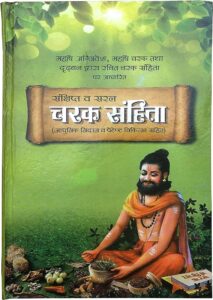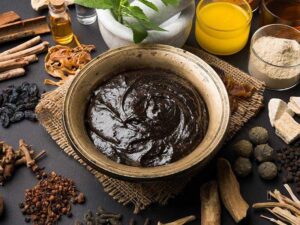 Chyawanprash, an ancient Ayurvedic concoction, is a known Indian traditional medicine with rejuvenating and health-promoting properties. Referred alternatively as Chyavanaprasha, Chyavanprash, Chyaanaprasam, and Chyawanaprash, the tale of its origin can be traced etymologically. ‘Chyawanprash’ is a composite term comprised of the two lexes, ‘Chyawan’ and ‘Prasha’. In Sanskrit, ‘Chyawan’ embodies ‘degenerative change’ while ‘Prasha’ denotes a specially prepared food or drug. ‘Chyavan’ is also the name of a sage and when seen in the context of Ayurveda, Chyawanprash represents an ancient nutritive formulation devised for Sage Chyawan to rejuvenate his youth and vitality. Widely acknowledged as a vital health supplement, Chyawanprash has endured through centuries, finding mention in classical Indian literature such as the Charak Samhita and various Ayurvedic texts.
Chyawanprash, an ancient Ayurvedic concoction, is a known Indian traditional medicine with rejuvenating and health-promoting properties. Referred alternatively as Chyavanaprasha, Chyavanprash, Chyaanaprasam, and Chyawanaprash, the tale of its origin can be traced etymologically. ‘Chyawanprash’ is a composite term comprised of the two lexes, ‘Chyawan’ and ‘Prasha’. In Sanskrit, ‘Chyawan’ embodies ‘degenerative change’ while ‘Prasha’ denotes a specially prepared food or drug. ‘Chyavan’ is also the name of a sage and when seen in the context of Ayurveda, Chyawanprash represents an ancient nutritive formulation devised for Sage Chyawan to rejuvenate his youth and vitality. Widely acknowledged as a vital health supplement, Chyawanprash has endured through centuries, finding mention in classical Indian literature such as the Charak Samhita and various Ayurvedic texts.
Esteemed as an integral component of Ayurvedic tradition, the genesis of Chyawanprash is shrouded in mythological narratives. The Mahabharata, Puranas, and other sacred texts recount the Aśvins (divine physicians during the Vedic era) crafting this polyherbal concoction. Legend holds that the formulation transpired at Chyawan’s hermitage near Dhosi Hill in Haryana, India. The sage, a contemporary of Manu and a descendant of Bhrigu, sought enlightenment through ascetic practices. Intense practices caused accelerated ageing and to Chyawan’s rescue came the Aśvins, the celestial twin deity of the Ṛgveda, who bestowed upon him a health-enhancing jam-like tonic, to restore his strength, vigour, vitality, and youthfulness, which subsequently known as Chyawanprash: the food of sage Chyawan. This version is mentioned in the Ṛgveda while describing the Aśvins and their magico-healing powers.
Another legend involves King Sharyati and his daughter, Princess Sukanya. It narrates the inadvertent blinding of Sage Chyawan by the princess when she poked his eyes with a stick, mistaking him for an anthill. The cause of this confusion was that Chyawan had been meditating for a long time and his entire body, save his eyes and nose, were covered in white ants. Subsequently, Chyawan, in a fit of anger, cursed the Sharyati lineage. Seeking appeasement, King Sharyati offered Sukanya’s hand in marriage to Chyawan. The compassionate demeanour and devoted service of Princess Sukanya garnered the approval of the Ashvini Kumaras, who bestowed a rejuvenating recipe, subsequently named “Chyawanprash,” to restore Chyawan’s vitality after years of meditation-induced decline (Ojha, 2003).

An alternative rendition commences post-Sukanya and Chyawan’s union, wherein the celestial twins, Ashvini Kumaras, encountered the couple. Attempting to allure Sukanya away, they proposed she abandon the aged Chyawan for one of them. Sukanya’s steadfast refusal impressed the Ashvins, who, possessing medicinal expertise, facilitated a transformative three-phase treatment that resulted in rejuvenating Chyawan’s health.
A less widespread narrative revolves around Rishi Chyawan’s pursuit of enlightenment, which provoked concern among the gods (Devas) fearing his ascension to the heavens. Employing the beautiful Menaka as a distraction, the Devas sought to divert Chyavan from his meditative pursuits. Menaka’s efforts, involving enticing stimuli, led Chyavan to abandon his spiritual goals in favour of a relationship with Menaka. To counter the challenges arising from the significant age difference and Menaka’s immortality, Chyavan sought a solution in the form of a mysterious elixir, now identified as Chyawanprash. Following its consumption, Chyavan regained his youthfulness, enabling a harmonious coexistence with Menaka. This enigmatic elixir, Chyawanprash, facilitated a contented and enduring union between Chyavan and Menaka.
 Indeed Chyawanprash, exhibiting a myriad of health benefits, has been employed since antiquity as both a health supplement and medicinal agent. Conforming to traditional Ayurvedic principles, it represents a polyherbal jam formulated through an Ayurvedic recipe, featuring a concentrated amalgamation of nutrient-rich herbs, herbal extracts, and processed minerals. Amla/Amalaki pulp, endowed with potent antioxidant properties, serves as its foundational component. Functioning as an Awaleha, a subset of Ayurvedic formulations, Chyawanprash is adeptly crafted through the processing of approximately 50 medicinal herbs, rendering it the paramount Rasayana according to the Charaka Samhita. The Chyawanprash formula, elucidated in ancient Ayurvedic texts such as Ashtanga Hridayam, Charaka Samhita, and Sangandhara Samhita, delineates a strategic combination of herbal classes, including Dashmula, Chaturjata, Ashtavarga, and a general category. The comprehensive nature of its composition underscores its efficacy in sustaining homeostasis. Its prescribed use aims at fortifying vitality, stamina, and overall well-being while retarding the ageing process by restoring the drained reserves of ojas (life force).
Indeed Chyawanprash, exhibiting a myriad of health benefits, has been employed since antiquity as both a health supplement and medicinal agent. Conforming to traditional Ayurvedic principles, it represents a polyherbal jam formulated through an Ayurvedic recipe, featuring a concentrated amalgamation of nutrient-rich herbs, herbal extracts, and processed minerals. Amla/Amalaki pulp, endowed with potent antioxidant properties, serves as its foundational component. Functioning as an Awaleha, a subset of Ayurvedic formulations, Chyawanprash is adeptly crafted through the processing of approximately 50 medicinal herbs, rendering it the paramount Rasayana according to the Charaka Samhita. The Chyawanprash formula, elucidated in ancient Ayurvedic texts such as Ashtanga Hridayam, Charaka Samhita, and Sangandhara Samhita, delineates a strategic combination of herbal classes, including Dashmula, Chaturjata, Ashtavarga, and a general category. The comprehensive nature of its composition underscores its efficacy in sustaining homeostasis. Its prescribed use aims at fortifying vitality, stamina, and overall well-being while retarding the ageing process by restoring the drained reserves of ojas (life force).
Modern scientific scrutiny corroborates the historic medicinal claims of Chyawanprash. The herbal and spicy constituents of Chyawanprash contribute to circulatory system convalescence, toxin elimination, and metabolic enhancement. Additionally, its positive impact on cardiac structure and function, correction of blood disorders, gastrointestinal benefits, blood purification, liver detoxification, and respiratory system fortification align with documented scientific findings. Chyawanprash’s multifaceted effects extend to neurological well-being, serving as an anxiolytic and antidepressant, while promoting improved memory, learning, and overall cognitive function. Its positive influence on reproductive health, bone and muscle strength, weight gain, and enhanced nutrient absorption further solidify its status as a comprehensive medicinal food within the Ayurvedic tradition. Chyawanprash has become deeply ingrained in Indian culture and is considered a symbol of well-being and longevity. It is often consumed during the changing seasons, especially in winter, to strengthen the immune system and ward off illnesses.

Chyawanprash is a harmonious blend of mythology, cultural heritage, and scientific validation. It stands as a testament to the ancient wisdom embedded in Ayurveda and the rich cultural heritage of India. The tradition of incorporating Chyawanprash into one’s daily routine has been passed down through generations, emphasizing its time-tested effectiveness. Its origins, rooted in a mythical narrative of rejuvenation, continue to resonate with millions who seek not just an herbal remedy but a holistic approach to health. Though the elixir of Chyawanprash transcends time, it yet struggles to compete with globalisation and modern allopathic and homoeopathic medicines prescribed by doctors. For many, it has been relegated to the position of a preventive tonic, shoved down their throats by their elders during winters. Although its authoritative position as medicine is lost, it remains a timeless embodiment of the delicate interplay between nature, spirituality, and human well-being.

